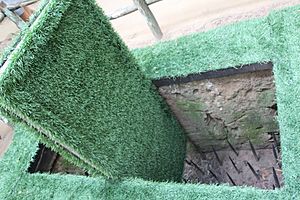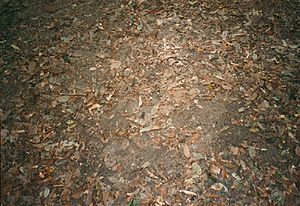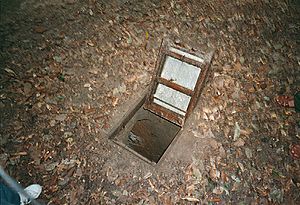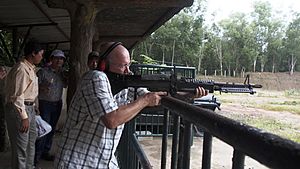Củ Chi tunnels facts for kids
The Củ Chi tunnels (Vietnamese: Địa đạo Củ Chi) are a huge network of connecting tunnels located in the Củ Chi District of Ho Chi Minh City (Saigon), Vietnam. These tunnels are part of a much larger system that runs under a lot of the country. During the Vietnam War, the Củ Chi tunnels were very important for several military actions. They were also the main base for the Viet Cong during the Tết Offensive in 1968.
Viet Cong soldiers used the tunnels as hiding spots during battles. They also served as routes for communication and supplies, hospitals, and places to store food and weapons. Many North Vietnamese fighters lived in them too. These tunnel systems were extremely important for the Viet Cong as they fought against American and ARVN forces. They helped the Viet Cong stand strong against the growing American military presence.
The tunnels had many bamboo traps made by the Viet Cong. These traps were designed to hurt or even kill South Vietnam's "tunnel rats" if they entered the tunnels. The tunnels also had special shafts to let out smoke from fires. They could also release any poisonous gases that American soldiers, called G.I., might pump into the tunnels.
Contents
Life Underground: Surviving in the Tunnels
American soldiers called the conditions inside the tunnels "Black Echo." Life for the Viet Cong in these tunnels was very tough. There was not much fresh air, food, or water. The tunnels were also full of ants, venomous centipedes, snakes, scorpions, spiders, and rodents.
Most of the time, soldiers would spend their days working or resting in the tunnels. They would only come out at night to find supplies, take care of their crops, or fight the enemy. Sometimes, during heavy bombing or when many American troops were moving, they had to stay underground for many days. Sickness was common among the people living in the tunnels. Malaria was a big problem, and many soldiers also had stomach issues.
Fighting the Tunnels: U.S. Campaigns
U.S. officials quickly realized how useful the Củ Chi tunnels were for the Viet Cong. Because of this, they started several big military operations to find and destroy the tunnel system. Two of the most important operations were Operation Crimp and Operation Cedar Falls.
Operation Crimp: The First Big Push
Operation Crimp started on January 7, 1966. Giant B-52 bombers dropped huge amounts of explosives on the Củ Chi region. This turned the once green jungle into a landscape full of craters. Eight thousand troops from the U.S. 1st Infantry Division, the 173rd Airborne Brigade Combat Team, and the 1st Battalion, Royal Australian Regiment searched the area for any signs of Viet Cong activity.

This operation did not work as well as planned. When troops found a tunnel, they often did not realize how big it was. It was very dangerous to go inside, so usually no one was sent in. The tunnels often had explosive booby traps or pits with sharp punji sticks. The usual ways to deal with a tunnel opening were to fill it with gas, water, or hot tar to force soldiers out. Or, they would throw grenades down the hole to "crimp" (close) it off. These methods were not effective because of how the tunnels were built, with hidden trap doors and air systems.
However, a special Australian engineering team, 3 Field Troop, led by Captain Alexander "Sandy" MacGregor, bravely went into the tunnels. They searched for four days and found ammunition, radio equipment, medical supplies, food, and clear signs that many Viet Cong were using the tunnels. One of their soldiers, Corporal Robert "Bob" Bowtell, died when he got stuck in a tunnel that was a dead end. But the Australians kept going and showed everyone how important these tunnels were for the military.
At a press conference in Saigon after Operation Crimp, MacGregor called his men "tunnel ferrets." An American journalist, who had never heard of ferrets, used the term "tunnel rat," and the name stuck. Captain MacGregor received a Military Cross for his troop's important discoveries in Củ Chi.
The Rise of the "Tunnel Rats"
After their mistakes and the Australians' discoveries, U.S. command realized they needed a new way to deal with the tunnels. General Williamson, the Allied Forces Commander in South Vietnam, ordered all Allied forces to properly search any tunnels they found. They began training a special group of volunteers in tunnel warfare. These specialists, known as "tunnel rats," would enter a tunnel alone. They were armed only with a handgun, a knife, a flashlight, and a piece of string. They would move slowly, inch by inch, carefully looking for booby traps or cornered Viet Cong fighters. There was no strict rulebook for this job. Even though some parts of the Army tried to provide training and tools, it was mostly up to each unit to train and plan for themselves.
Operation Cedar Falls: A Larger Attack
Even with the new "tunnel rat" approach, U.S. operations could not completely get rid of the tunnels. In 1967, General William Westmoreland tried a bigger attack on Củ Chi and the Iron Triangle. This operation was called Operation Cedar Falls. It was similar to Operation Crimp but much larger, with 30,000 troops instead of 8,000.
On January 18, "tunnel rats" from the 1st Battalion, 5th Infantry Regiment, 25th Infantry Division found the Viet Cong district headquarters in Củ Chi. Inside, they found half a million documents about all kinds of military plans. These documents included maps of U.S. bases, detailed records of Viet Cong movement from Cambodia into Vietnam, lists of people who supported them, and even plans to target important officials.
By 1969, B-52 bombers were able to stop bombing North Vietnam and started "carpet bombing" Củ Chi and the rest of the Iron Triangle. Towards the end of the war, some parts of the tunnels were bombed so heavily that they collapsed, and other sections were exposed. But even these bombings could not destroy most of the tunnels.
Throughout the war, the tunnels in and around Củ Chi were a constant problem for the U.S. military in Saigon. By 1965, the Viet Cong were so well hidden in the area that they could choose where and when battles would happen. The Củ Chi tunnels helped North Vietnamese fighters in South Vietnam survive by secretly moving supplies and housing troops. This helped to make the war last longer and increased the costs and losses for the U.S. until their withdrawal in 1973. The war finally ended with the defeat of South Vietnam in 1975.
Visiting the Tunnels Today
The 75-mile (121 km)-long tunnel complex at Củ Chi has been kept safe by the government of Vietnam after the country was reunited. It has been turned into a war memorial park with two different tunnel display sites: Ben Dinh and Ben Duoc.
The tunnels are a very popular tourist attraction in Vietnam. Visitors can crawl through the safer parts of the tunnel system. The Ben Duoc site has parts of the original tunnel system. The Ben Dinh site, which is closer to Ho Chi Minh City, has rebuilt tunnels, and some have been made wider to fit tourists. At both sites, dim lights have been added to the tunnels to make it easier to move around. Both sites also show examples of the different types of booby traps that were used. Underground meeting rooms, where important plans like the Tết Offensive were made in 1968, have been restored.
Above ground, visitors can see caged monkeys, buy souvenirs from vendors, and even visit a shooting range.
See also
 In Spanish: Túneles de Cuchi para niños
In Spanish: Túneles de Cuchi para niños
- Vịnh Mốc tunnels
- Củ Chi Base Camp
- Tunnel warfare
- Urban warfare
- Palestinian tunnel warfare in the Gaza Strip
- Hezbollah tunnels




